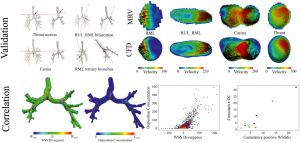当前位置:
X-MOL 学术
›
Comput. Biol. Med.
›
论文详情
Our official English website, www.x-mol.net, welcomes your
feedback! (Note: you will need to create a separate account there.)
Particle transport and deposition correlation with near-wall flow characteristic under inspiratory airflow in lung airways.
Computers in Biology and Medicine ( IF 7.0 ) Pub Date : 2020-03-14 , DOI: 10.1016/j.compbiomed.2020.103703 Ali Farghadan 1 , Kamran Poorbahrami 2 , Sahar Jalal 3 , Jessica M Oakes 4 , Filippo Coletti 3 , Amirhossein Arzani 1
Computers in Biology and Medicine ( IF 7.0 ) Pub Date : 2020-03-14 , DOI: 10.1016/j.compbiomed.2020.103703 Ali Farghadan 1 , Kamran Poorbahrami 2 , Sahar Jalal 3 , Jessica M Oakes 4 , Filippo Coletti 3 , Amirhossein Arzani 1
Affiliation

|
Exposure of lung airways to detrimental suspended aerosols in the environment increases the vulnerability of the respiratory and cardiovascular systems. In addition, recent developments in therapeutic inhalation devices magnify the importance of particle transport. In this manuscript, particle transport and deposition patterns in the upper tracheobronchial (TB) tree were studied where the inertial forces are considerable for microparticles. Wall shear stress divergence (WSSdiv) is proposed as a wall-based parameter that can predict particle deposition patterns. WSSdiv is proportional to near-wall normal velocity and can quantify the strength of flow towards and away from the wall. Computational fluid dynamics (CFD) simulations were performed to quantify airflow velocity and WSS vectors for steady inhalation in one case-control and unsteady inhalation in six subject-specific airway trees. Turbulent flow simulation was performed for the steady case using large eddy simulation to study the effect of turbulence. Magnetic resonance velocimetry (MRV) measurements were used to validate the case-control CFD simulation. Inertial particle transport was modeled by solving the Maxey-Riley equation in a Lagrangian framework. Deposition percentage (DP) was quantified for the case-control model over five particle sizes. DP was found to be proportional to particle size in agreement with previous studies in the literature. A normalized deposition concentration (DC) was defined to characterize localized deposition. A relatively strong correlation (Pearson value > 0.7) was found between DC and positive WSSdiv for physiologically relevant Stokes (St) numbers. Additionally, a regional analysis was performed after dividing the lungs into smaller areas. A spatial integral of positive WSSdiv over each division was shown to maintain a very strong correlation (Pearson value > 0.9) with cumulative spatial DC or regional dosimetry. The conclusions were generalized to a larger population in which two healthy and four asthmatic patients were investigated. This study shows that WSSdiv could be used to predict the qualitative surface deposition and relative regional dosimetry without the need to solve a particle transport problem.
中文翻译:

吸气气流在肺气道中的颗粒传输和沉积与近壁流特征的关系。
肺气道暴露于环境中有害的悬浮气溶胶会增加呼吸系统和心血管系统的脆弱性。另外,治疗性吸入装置的最新发展放大了颗粒运输的重要性。在此手稿中,研究了气管支气管上层(TB)树中的颗粒运输和沉积模式,其中惯性力对于微粒而言相当大。提出了壁切应力发散度(WSSdiv)作为可预测颗粒沉积模式的基于壁的参数。WSSdiv与近壁法向速度成正比,并且可以量化流向和流出壁的强度。进行了计算流体动力学(CFD)仿真,以量化气流速度和WSS向量,以便在一种病例对照中稳定吸入,在六种特定受试者的气道树中不稳定吸入。使用大涡模拟对稳态情况进行湍流模拟,以研究湍流的影响。磁共振测速(MRV)测量用于验证病例对照CFD模拟。通过在拉格朗日框架中求解Maxey-Riley方程对惯性粒子传输进行建模。对于病例对照模型,对五种粒径的沉积百分比(DP)进行了定量。发现DP与粒度成比例,这与文献中先前的研究一致。定义归一化沉积浓度(DC)以表征局部沉积。对于生理相关的斯托克斯(St)数,在DC和正WSSdiv之间发现了相对较强的相关性(Pearson值> 0.7)。此外,在将肺部分成较小区域后进行了区域分析。显示每个分区上正WSSdiv的空间积分与累积空间DC或区域剂量法保持非常强的相关性(Pearson值> 0.9)。结论被推广到更大的人群,其中调查了两名健康患者和四名哮喘患者。这项研究表明,WSSdiv可用于预测定性表面沉积和相对区域剂量,而无需解决粒子传输问题。将肺分为较小区域后,进行了区域分析。显示每个分区上正WSSdiv的空间积分与累积空间DC或区域剂量法保持非常强的相关性(Pearson值> 0.9)。结论被推广到更大的人群,其中调查了两名健康患者和四名哮喘患者。这项研究表明,WSSdiv可以用于预测定性表面沉积和相对区域剂量,而无需解决粒子传输问题。将肺分为较小区域后,进行了区域分析。显示每个分区上正WSSdiv的空间积分与累积空间DC或区域剂量法保持非常强的相关性(Pearson值> 0.9)。结论被推广到更大的人群,其中调查了两名健康患者和四名哮喘患者。这项研究表明,WSSdiv可以用于预测定性表面沉积和相对区域剂量,而无需解决粒子传输问题。结论被推广到更大的人群,其中调查了两名健康患者和四名哮喘患者。这项研究表明,WSSdiv可以用于预测定性表面沉积和相对区域剂量,而无需解决粒子传输问题。结论被推广到更大的人群,其中调查了两名健康患者和四名哮喘患者。这项研究表明,WSSdiv可以用于预测定性表面沉积和相对区域剂量,而无需解决粒子传输问题。
更新日期:2020-04-20
中文翻译:

吸气气流在肺气道中的颗粒传输和沉积与近壁流特征的关系。
肺气道暴露于环境中有害的悬浮气溶胶会增加呼吸系统和心血管系统的脆弱性。另外,治疗性吸入装置的最新发展放大了颗粒运输的重要性。在此手稿中,研究了气管支气管上层(TB)树中的颗粒运输和沉积模式,其中惯性力对于微粒而言相当大。提出了壁切应力发散度(WSSdiv)作为可预测颗粒沉积模式的基于壁的参数。WSSdiv与近壁法向速度成正比,并且可以量化流向和流出壁的强度。进行了计算流体动力学(CFD)仿真,以量化气流速度和WSS向量,以便在一种病例对照中稳定吸入,在六种特定受试者的气道树中不稳定吸入。使用大涡模拟对稳态情况进行湍流模拟,以研究湍流的影响。磁共振测速(MRV)测量用于验证病例对照CFD模拟。通过在拉格朗日框架中求解Maxey-Riley方程对惯性粒子传输进行建模。对于病例对照模型,对五种粒径的沉积百分比(DP)进行了定量。发现DP与粒度成比例,这与文献中先前的研究一致。定义归一化沉积浓度(DC)以表征局部沉积。对于生理相关的斯托克斯(St)数,在DC和正WSSdiv之间发现了相对较强的相关性(Pearson值> 0.7)。此外,在将肺部分成较小区域后进行了区域分析。显示每个分区上正WSSdiv的空间积分与累积空间DC或区域剂量法保持非常强的相关性(Pearson值> 0.9)。结论被推广到更大的人群,其中调查了两名健康患者和四名哮喘患者。这项研究表明,WSSdiv可用于预测定性表面沉积和相对区域剂量,而无需解决粒子传输问题。将肺分为较小区域后,进行了区域分析。显示每个分区上正WSSdiv的空间积分与累积空间DC或区域剂量法保持非常强的相关性(Pearson值> 0.9)。结论被推广到更大的人群,其中调查了两名健康患者和四名哮喘患者。这项研究表明,WSSdiv可以用于预测定性表面沉积和相对区域剂量,而无需解决粒子传输问题。将肺分为较小区域后,进行了区域分析。显示每个分区上正WSSdiv的空间积分与累积空间DC或区域剂量法保持非常强的相关性(Pearson值> 0.9)。结论被推广到更大的人群,其中调查了两名健康患者和四名哮喘患者。这项研究表明,WSSdiv可以用于预测定性表面沉积和相对区域剂量,而无需解决粒子传输问题。结论被推广到更大的人群,其中调查了两名健康患者和四名哮喘患者。这项研究表明,WSSdiv可以用于预测定性表面沉积和相对区域剂量,而无需解决粒子传输问题。结论被推广到更大的人群,其中调查了两名健康患者和四名哮喘患者。这项研究表明,WSSdiv可以用于预测定性表面沉积和相对区域剂量,而无需解决粒子传输问题。











































 京公网安备 11010802027423号
京公网安备 11010802027423号